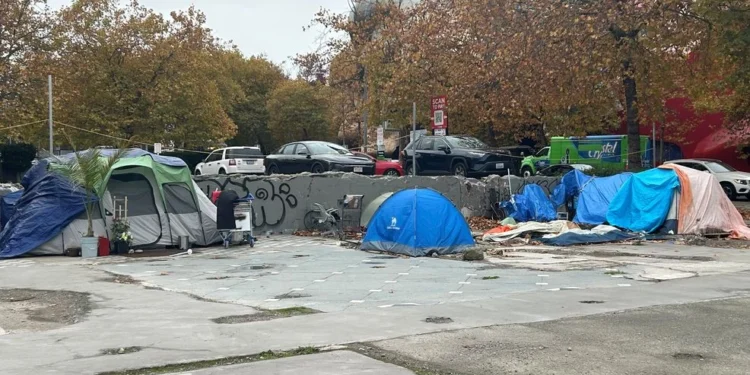Whether viewed as a short-term homeless crisis solution or a potential shantytown, a Seattle city leader wants to explore establishing a sanctioned encampment to assist people living on streets.
Seattle City Councilmember Joy Hollingsworth stated the concept involves designating a space where homeless individuals could legally pitch tents in a managed environment and access services.
“I am not proposing an encampment where it’s just a free-for-all,” Hollingsworth stated.
As Seattle City Council members negotiate next year’s budget, Hollingsworth has identified several public safety investments. One involves designating and funding a site for a homeless camp.
“I want to see more of a coordinated response from our city regarding this,” Hollingsworth stated, “understanding that finding land is really difficult in our city.”
Unauthorized encampments experience distress and disorder, but the city could manage a location and provide restrooms, on-site security, case management, and mobile drug treatment, according to Hollingsworth. She acknowledges numerous critics exist.
“A lot of people say, ‘Well, you know, people need long-term housing.’ Well, that takes a long time to build, so while we’re waiting for those structures to be in place and housing to be built, let’s get people into shelter right now,” Hollingsworth stated.
In 2013, a city-sanctioned encampment in West Seattle called Nickelsville expanded to approximately 170 people but rapidly became problematic and was eventually cleared due to infestations, flooding, and disruptive residents.
In contrast, Tent City 3, hosted on a rotating basis by faith-based organizations, has operated for decades.
Bruce Drager, an activist with the Ballard Community Taskforce on Homelessness and Hunger, has long advocated for sanctioned encampments. Drager has also regularly criticized sweeps, which he stated accomplish nothing.
“The main thing is that we need to have a place where people can continue to live stably and safely and continue to receive the services that actually get them on the pathway to housing,” Drager stated, “rather than shifting them around from one spot to the next because then we make no progress with people if the service providers can’t find them.”
Hollingsworth also wants to provide stability, but stated that if they reach the point of selecting a site, the city’s parks will remain off-limits.
“We can’t have people in parks who are using drugs around kids. Foil, needles, you can’t have that,” Hollingsworth stated, “but what we can have is making sure that people have someplace to go.”
Hollingsworth indicated she will issue a Statement of Legislative Intent to request a study of what a sanctioned encampment could entail.
“This isn’t a long-term solution at all,” she stated. “This is something that is on the pathway to housing.”
Establishing sanctioned encampments represents one element in a series of public safety investments Hollingsworth wants to pursue addressing problems using tools and resources already available.
Regarding the district she represents, which includes Capitol Hill and First Hill, Hollingsworth also wants increased Community Assisted Response & Engagement Team presence, as well as Seattle Police Department, along the Pike/Pine corridor and throughout Broadway.
She also wants to add ambassadors to these areas, modeled after the program in the Chinatown-International District. Beyond that, she plans to push for the King County Council to increase its current $1 million allocation for Capitol Hill/First Hill cleanup to $3 million, prioritizing the area near the Polyclinic, the future home of the Crisis Care Clinic.
Other concepts include additional environmental design improvements such as lighting upgrades, beautification, and traffic flow enhancements to make streets safer and more welcoming.
All this occurs as the King County Regional Homelessness Authority announced staffing cuts to offset an administrative budget shortfall.
KCRHA eliminated 13 positions, a 22% reduction including both managers and union-represented staff. KCRHA will also freeze hiring on another 15 vacant positions.
KCRHA faces a $4.7 million budget shortfall for 2026, and this reduction round will save approximately $3 million, according to a press release.
The sanctioned encampment proposal representing Councilmember Hollingsworth’s pragmatic approach acknowledging that permanent housing construction timelines measured in years cannot address immediate shelter needs, with the intermediate solution attempting to bridge the gap between street homelessness and permanent supportive housing that advocates demand but developers cannot rapidly deliver.
The “not a free-for-all” clarification preemptively addressing critics who conflate sanctioned encampments with chaotic unauthorized camps, with Hollingsworth’s emphasis on managed settings attempting to distinguish her proposal from disorder that characterizes unsupervised tent cities generating neighborhood complaints.
The budget negotiation timing for the sanctioned camp proposal demonstrating Hollingsworth’s strategic approach using annual appropriations process to advance policy objectives, with the budget cycle creating opportunity to secure funding commitments that transform abstract proposals into concrete programs with dedicated resources.
The coordinated city response emphasis reflecting frustration with fragmented homeless services where multiple agencies pursue uncoordinated strategies producing duplicative efforts and gaps in coverage, with Hollingsworth’s call for coordination suggesting current approaches lack central planning connecting shelter, services, and housing pathways.
The land scarcity acknowledgment recognizing Seattle’s constrained geography where available public property faces competing demands from parks, infrastructure, and development, with the admission signaling that site selection will generate controversy as neighborhoods resist hosting encampments despite acknowledging homelessness crisis severity.
The managed location concept featuring restrooms, security, case management, and mobile drug treatment representing comprehensive service model addressing both immediate survival needs and longer-term stabilization, with the amenities attempting to create conditions enabling effective interventions rather than warehousing people in tent cities without support.
The “people need long-term housing” criticism Hollingsworth anticipates reflecting progressive advocates’ position that temporary shelters perpetuate homelessness rather than solving it, with the housing-first philosophy arguing that sanctioned camps divert resources from permanent housing construction while normalizing tent living as acceptable policy response.
The 2013 Nickelsville West Seattle precedent providing cautionary tale about sanctioned encampment failures, with the rapid deterioration from 170 residents to “disastrous” conditions involving infestations and flooding demonstrating how quickly managed sites can devolve without adequate oversight, maintenance, and behavioral standards.
The Tent City 3 contrasting success story operating for decades through faith-based rotation model suggesting that community hosting combined with organizational structure can sustain functional encampments, with the longevity demonstrating that sanctioned camps can work when designed thoughtfully and supported consistently.
Bruce Drager’s advocacy for sanctioned encampments as alternative to sweeps articulating harm reduction argument that stable locations enable service delivery impossible when people scatter after enforcement actions, with the stability emphasis reflecting service provider frustration when clients disappear during sweeps interrupting case management relationships.
The sweep criticism that they “accomplish nothing” representing activist perspective that enforcement without housing alternatives merely moves visible homelessness between neighborhoods rather than resolving underlying crisis, with the argument challenging city’s reliance on periodic clearances as primary homelessness intervention.
Hollingsworth’s parks exclusion pledge attempting to address parents’ and recreation advocates’ concerns that encampments in playgrounds and athletic fields expose children to drug use and discarded paraphernalia, with the restriction acknowledging political reality that parks department and neighborhood groups will vigorously oppose any encampment proposals threatening recreational spaces.
The Statement of Legislative Intent mechanism representing formal process requesting city departments conduct feasibility studies, with the procedural step enabling Hollingsworth to advance her proposal through bureaucratic channels generating official analysis that informs subsequent policy decisions.
The “pathway to housing” framing positioning sanctioned encampments as transitional intervention rather than permanent accommodation, with the language attempting to satisfy housing advocates who oppose indefinite tent cities while providing immediate shelter alternative to street homelessness.
The Capitol Hill and First Hill focus reflecting Hollingsworth’s district representation where Pike/Pine corridor and Broadway experience concentrated visible homelessness generating constituent complaints, with the geographic targeting suggesting councilmember responds to specific neighborhood concerns rather than pursuing citywide homelessness strategy.
The Community Assisted Response & Engagement Team expansion proposal emphasizing alternative crisis response sending social workers and mental health professionals instead of police, with the CARE team model representing Seattle’s attempt at reimagining public safety by deploying specialized responders for non-criminal behavioral health situations.
The ambassador program modeled after Chinatown-International District demonstrating Hollingsworth’s interest in replicating successful approaches, with the CID ambassadors providing street-level presence combining hospitality for visitors with informal social services connecting homeless individuals to resources.
The $3 million King County funding request tripling current $1 million Capitol Hill/First Hill cleanup allocation reflecting the area’s deteriorating conditions requiring enhanced maintenance, with the Polyclinic/Crisis Care Clinic proximity priority suggesting coordination between street-level interventions and behavioral health infrastructure.
The environmental design improvements including lighting, beautification, and traffic flow representing Crime Prevention Through Environmental Design principles suggesting that physical improvements can reduce disorder, with the approach assuming that attractive well-lit streets deter problematic behaviors while enhancing neighborhood perception of safety.
The KCRHA staffing cuts and budget shortfall providing broader context where the regional homelessness authority’s fiscal crisis undermines coordinated response capacity, with the administrative reductions potentially reducing oversight and contract management capabilities exactly when Hollingsworth proposes expanding sanctioned encampment programs requiring intensive management.







